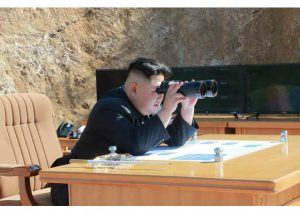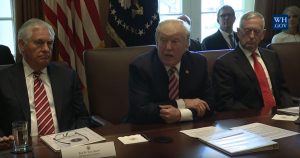What North Korea’s IC May be Whispering to Kim Jong Un About US Intentions
As the Trump administration navigates through a series of historically unprecedented North Korean crises, questions abound regarding the specifics of US policy on North Korea. Will the US initiate preventive military action against North Korea? What would be the trigger? When such questions arise, American policymakers turn to the intelligence community (IC) to reduce the uncertainties that surround decision-making.

North Korea is no different. Kim Jong Un and his military advisors are likely asking the same questions to the North Korean IC—the Reconnaissance General Bureau (RGB). As one might expect, the architecture of the North Korean IC is vastly different from that of the United States and has inherent limitations that favor a reliance on open-source intelligence (OSINT), such as news media, social media and publicly-available information. In fact, one US news correspondent recently reported that North Korean officials tune in to MSNBC’s “Morning Joe” to glean insights into US policy discussions. If this is true, do statements from President Trump that consistently advertise lethal military options against North Korea carry weight? The answer appears to be no, at least until other administration officials provide amplifying comments, whether consistent or contradictory, on US North Korea policy.
Evaluative Language in Intelligence
When intelligence professionals make judgments on actions, capabilities and intentions of adversaries, they assign evaluative language to them. Evaluative language includes both estimative terms that reflect the likelihood of certain actions or events and measures of confidence which reflect the subjective assessment on the quality and reliability of supporting intelligence.[1] Using such language helps produce actionable intelligence that can guide important policy decisions, such as posturing military forces for decisive action against an adversary. The quality of supporting intelligence is the product of the extent and quality of a nation’s intelligence collection enterprise—for example, its network of overhead intelligence, surveillance and reconnaissance (ISR) assets, placement and access to adversary sources of information. Much of this rests on the ability to finance intelligence activities as well as physical access.
North Korea and OSINT
As a nation confronting significant financial constraints and limited foreign travel for the vast majority of its citizens, North Korea’s IC faces significant barriers to intelligence collection. Its ability to direct intelligence gathering against South Korea is one of the few exceptions to this reality. South Korea’s proximity and shared heritage and language enable the flow of information to the North that might benefit North Korean intelligence collection. It is no surprise that North Korean sleeper cells are active throughout South Korea and have been implicated in recent intelligence activities.
With regard to intelligence collection against the United States, however, North Korea leans heavily on OSINT—a readily available and potentially valuable source of reliable intelligence. Public statements from US officials and powerbrokers, in particular, can have added significance when they provide insights into US military courses of action. Corroboration through other intelligence disciplines can amplify the value of these statements. If, for example, North Korea were able to acquire and leverage long-range ISR platforms like the United States and its allies, it could exploit geospatial intelligence (GEOINT) to better ascertain whether US forces were actually postured for preventive military action. Without such capabilities, North Korea greatly appreciates OSINT exploitation.
Like their American adversary, North Korea’s intelligence analysts assign measures of analytic confidence to their intelligence sources—namely, the statements of US officials, power-brokers and other influential voices on US Asia policy. High-confidence intelligence can serve as effective guideposts for policy decisions. For example, former Director of National Intelligence James Clapper’s claim that North Korea will never relinquish its nuclear weapons likely sent a strong signal to North Korean intelligence officials that this represents the summary judgment of the American IC at-large based on its vast instruments of collection. North Korea may have read his opinion as “we, the US IC, assess with high confidence that North Korea will never relinquish nuclear weapons.” When viewed alongside the absence of US/South Korean military action, Pyongyang could have been convinced that such an intelligence judgment may have led the US to abandon the goal of denuclearizing North Korea. In other words, the DNI may have unwittingly served as a credible, high-confidence source for North Korean intelligence on US intentions. It is entirely possible that this may have emboldened North Korea to continue its aggressive pursuit of missile and nuclear development.
North Korea’s Intelligence Assessment of President Trump’s Rhetoric

On the contrary, North Korea appears to have dismissed the credibility of President Trump’s pronouncements of military action against North Korea, particularly in light of alternate and corroborative views. Secretary of Defense James Mattis and Secretary of State Rex Tillerson have both acknowledged a preference for diplomatic solutions, not military ones.[2] For an intelligence analyst, whether North Korean or American, assessing the probability of military action rests on the sum credibility of such individuals. Additional factors, like the assurances of American interlocutors engaged in Track II diplomacy, can bolster such assessments when they are consistent with official statements.
Of course, the question is, how do we know with reasonable certainty that North Korea actually favored such voices? One way, from the perspective of an intelligence analyst, is to assess the buildup of combat power. After North Korea’s retaliatory threats of a strike towards Guam, the US maintained normal operational readiness in and around the Korean peninsula: no evacuation of American citizens and no unusual troop deployments. If the US had heeded North Korea’s warning and prepared for military action against the United States, one would have expected an entirely different US reaction. Thus, North Korea could have simply interpreted President Trump’s fiery rhetoric and threats of military action as poor indicators of actual US policy responses. Pyongyang no doubt also learned a larger lesson—namely, that North Korea’s testing of strategic weapons capabilities fails to satisfy the threshold for US military action.
This is not to say that North Korea simply rejects President Trump’s statements as empty threats. No one, not even the US public, truly understands the Trump administration’s sensitivities for military action and what precisely constitutes a “red line” for the current administration. With the exception of the April strike against Shayrat Airfield in Syria in response to allegations of a Syrian regime-instigated chemical attack on civilians, we have yet to witness what actions by adversaries will trigger this administration to take strategically significant military action.
Until we collectively understand the logic of the Trump administration and the impetus for military action, it is critical that US interlocutors continue to convey the seriousness of potential US responses to North Korean actions both in an official and unofficial capacity. These individuals have a tremendous potential to influence North Korea’s OSINT intelligence apparatus so long as its overall intelligence capabilities remain unchanged.
Right now, we should not be surprised if the North’s intelligence community is advising their leader that they should heed the messages of the Trump administration as a whole, not simply those of President Trump.
- [1]
“Analytic Confidence and Political Decision Making: Theoretical Principles and Experimental Evidence from National Security Professionals” Friedman, Zeckhauser and Ramsey, May 2017, https://fas.org/irp/dni/icd/icd-203.pdf.
- [2]
“Rex Tillerson: US in contact with North Korea,” Al Jazeera, September 30, 2017, http://www.aljazeera.com/news/2017/09/rex-tillerson-china-korea-talks-170930035204341.html; Paul McLeary, “After Trump Speech, Mattis Says North Korea Crisis Still ‘Diplomatic Effort’,” Foreign Policy, September 20, 2017, http://foreignpolicy.com/2017/09/20/after-trump-speech-mattis-says-north-korea-crisis-still-diplomatic-effort/; Jim Mattis and Rex Tillerson, “Mattis and Tillerson: “We’re Holding Pyongyang to Account”,” Wall Street Journal, August 14, 2017, https://www.whitehouse.gov/the-press-office/2017/08/14/mattis-and-tillerson-were-holding-pyongyang-account.
